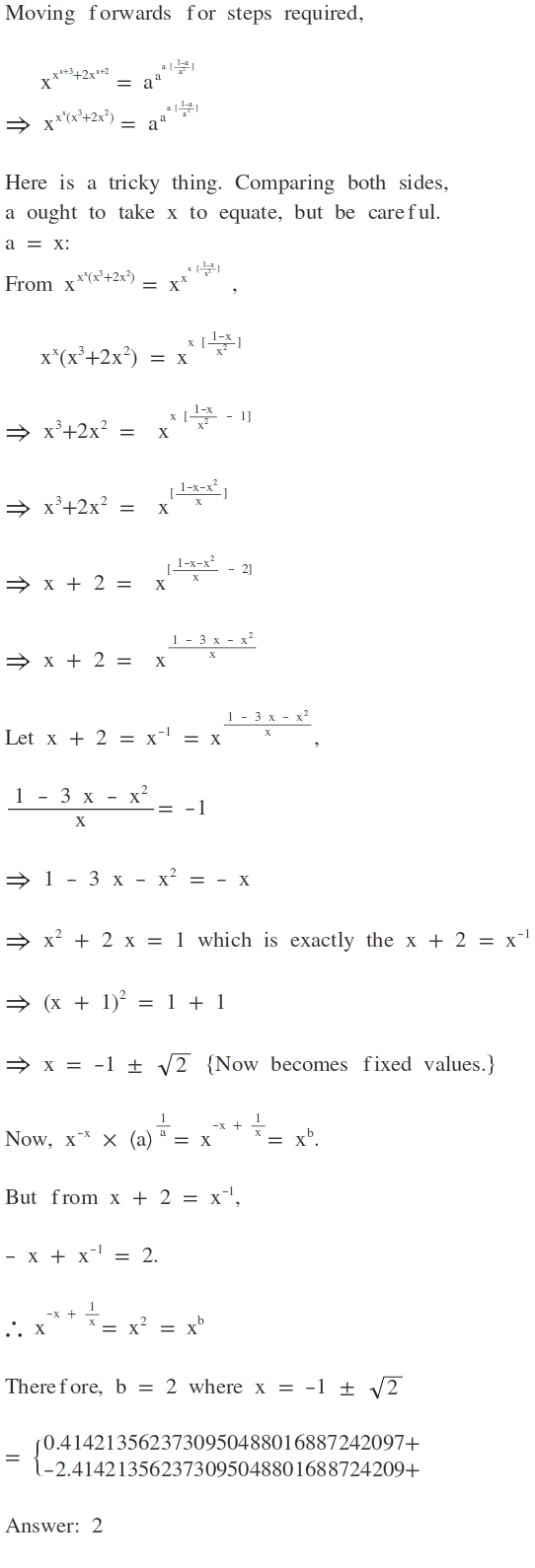Dedication pays off!
x x x + 3 × x 2 x x + 2 = a a ( 1 − a ) / a
For all x and a real numbers that satisfy the equation above, and given that
x − x × ( a 1 ) − a 1
can be expressed as x b , where b is an integer, find the value of b .
The answer is 2.
This section requires Javascript.
You are seeing this because something didn't load right. We suggest you, (a) try
refreshing the page, (b) enabling javascript if it is disabled on your browser and,
finally, (c)
loading the
non-javascript version of this page
. We're sorry about the hassle.
3 solutions
Since x = − 1 ± 2 as constants finally which are not arbitrary for an identity,
− x + x 1 = 2 is not the only thing because case of base x = a = 1 was ignored.
With x = a = 1 substituted into original equation,
L.H.S. = 1 = R.H.S.
b = − 1 + 1 1 = 0 else 1 ? = 1 b ,
b = 0, 1, 2 and etc with base 1 of original equation to take effect!
The answer of this question becomes ambiguous.
Only when I try to read the mind of the author, I got 2 as the answer wanted.
Log in to reply
I updated the problem to specify that b must be a integer satisfying the equation for all x and a that satisfy the original equation. Thanks. :)
Log in to reply
b = 0, 1 and 2 were integers. The thing is you ought to say that x (and also a) is (are) not an integer (example: 1).
Damn I solved it them by mistake clicked discuss solution
If we drop the (unstated) requirement that b be an integer, there is yet another solution. We have ( x x + 2 ) x x + 2 = a a a 1 − a and this second term is equal to a a when a = 2 1 . Thus we can have a = 2 1 and x x + 2 = a = 2 1 , which gives an approximate numerical solution x = 0 . 7 7 9 2 6 9 . The function x ↦ x x + 2 is strictly increasing on [ 0 , ∞ ) , and so the equation x x + 2 = 2 1 has a unique solution.
Then ( a − 1 ) − a − 1 = a a − 1 = 4 1 = a 2 = x 2 x + 4 , so that x b = x − x + 2 x + 4 = x x + 4 , and hence b = x + 4 = 4 . 7 7 9 2 6 9 .
Mark,
Why / how are you assuming the value of 'a' to be equal to 1/2 ?
Log in to reply
Because I want (1-a)/a to be 1.
Log in to reply
But that value of b don't stand for all a and x in that expression.
Log in to reply
@Gabriel Benício – The real problem is that you state that m m = n n implies that m = n . It does not. The function y = x x has a turning point at x = e − 1 , being decreasing for 0 < x < e − 1 and increasing for x > e − 1 .
If you could easily guarantee that x x + 2 and a a 1 are both greater than e − 1 , then you would be able to deduce that x x + 2 = a a 1 , which is what you want. That would be messy!
The simplest way of removing all difficulty would simply be to restrict solutions of the first identity to the range x , a ≥ 1 . In that case x x + 2 and a a 1 are both at least 1 , and so you can deduce that x x + 2 = a a 1 , and your proof will work.
@Gabriel Benício – But then your solution b = 2 does not work for my values of x and a , which do satisfy the first equation. In that sense, your answer is as wrong as mine!

The system of Brilliant could have made this page looked small to you. Please drag for another tag at the top to view with enlargement allowed. b = 0, 1, 2 and etc if not guessing the mind of the author when base 1 of original equation is considered.
First we have: ( x x x + 3 ) ( x 2 x x + 2 ) = x x x x 2 ( x + 2 ) = x x x + 2 ( x + 2 ) = ( x x + 2 ) x x + 2 .
On the other side: a a a 1 − a = a a a 1 − 1 = a a − 1 a a 1 = ( a a 1 ) a a 1
Let m = x x + 2 and n = a ( a 1 ) = ( a 1 ) − ( a 1 ) , then, from the first equation, we have
m m = n n ⟹ m = n
Finally, we have
x x + 2 = ( a 1 ) − ( a 1 ) ⟹ x 2 = x − x ( a 1 ) − ( a 1 )
Then, b = 2